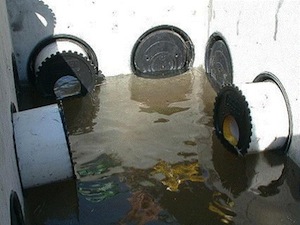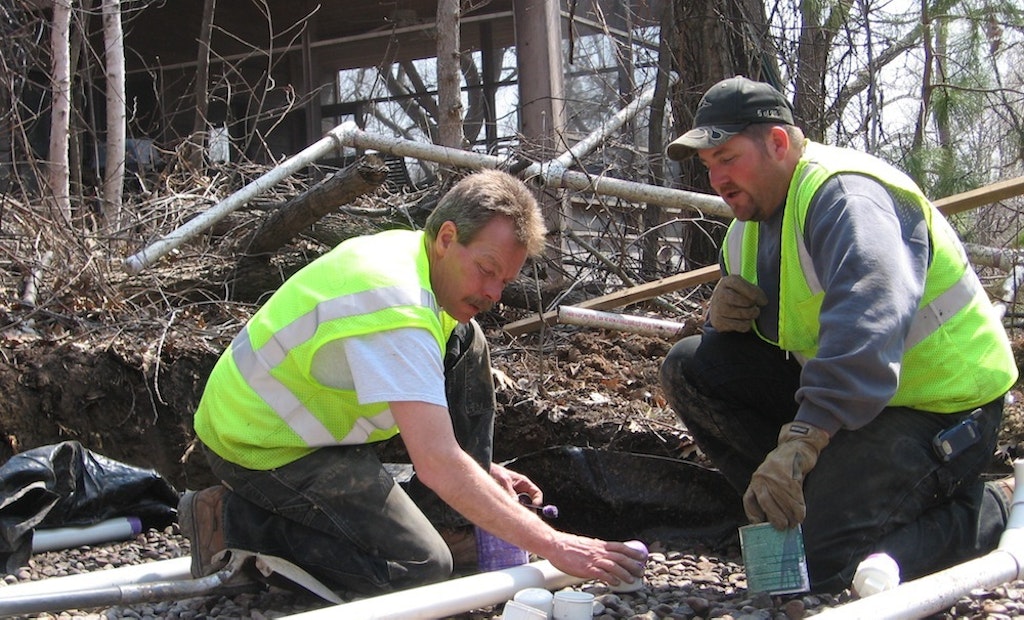Interested in Portable Sanitation?
Get Portable Sanitation articles, news and videos right in your inbox! Sign up now.
Portable Sanitation + Get AlertsHow do you help a property owner with a system that’s beginning to fail if they can’t afford a new system? Or help an owner make their system last as long as possible? There are relatively low-tech and low-cost solutions to help systems that may be struggling and to increase longevity for new systems. Below is a range of options to consider.
Effluent screens
Effluent screens are designed to help keep solids in the tank. These devices trap total suspended solids (TSS), reduce the TSS concentration in septic tank effluent and help protect the soil absorption field or other downstream treatment unit. They typically replace the outlet baffle in the final compartment of the tank. All wastewater that exits the tank must first pass through the screen. Independent research performed at Tennessee Technological University (Treanor, 1995) suggests that effluent screens do indeed reduce TSS as well as BOD in septic systems.
Several types of effluent screens are available, including multiple plates assembled with slots between, slotted cylinders and multiple perforated tubes assembled together. Others may be fitted with an alarm or used in conjunction with a pump for pressurized applications. Although it is easier to install effluent screens in a new septic tank, several types can be retrofitted to existing tanks. In addition to models that can be placed directly into concrete baffles, installation options include: replacement of PVC outlet tee or baffle with the effluent screen and housing, placement in a sump outside the tank or placement within the pump vault of a pumped system. Solid accumulation in the screen will cause poor performance of the septic tank, but creates a problem that is far easier and less expensive to clean and maintain than solids accumulation in the drainfield.
Zoning the soil treatment system
Dual-field systems allow for the effluent to be dispersed in one of two or more systems. With gravity distribution you may have the opportunity to operate the system to allow for resting and rejuvenation. If the system has a distribution or drop box, one or more lines can be shut off by accessing the box and capping the line or adjusting a leveler.

_(WEB).jpeg)
Drop box or distribution lines can be capped to allow for resting
In some applications, it is advantageous or required to zone a soil treatment system into several separate components. The goal may be to facilitate management, keep pump size reasonable or work within site limitations. Regardless of the reason, there are control panels and splitting devices a designer may choose to facilitate a zoned system.
Some systems will have a valve designed to allow alternating. Periodically, the valve is switched and the second soil treatment system is put into use while the first one is allowed to rest. This resting period allows the soil treatment system to have a break, and should allow for aerobic conditions to predominate, reducing the clogging potential of the biomat and rejuvenating the soil for phosphorus removal.
Once the first section of the system has developed a mature biomat, it can be diverted to the second section. Each zone can be used for up to one year, unless the effluent level indicates that a longer duration is feasible. Managing the development and existence of the biomat in the soil treatment system can contribute greatly to both the treatment performance and the lifespan of the soil treatment system.
In all soil conditions, the frequency of valve switching depends upon the rate of biomat development, which in turn is dependent upon the biological load and hydraulic flow of the effluent being treated and disposed at the site. In any case, proper management of the biomat — development, existence and resting/drying — is based upon observations of the soil treatment system ponding levels.
These routine observations will lead the service provider to select a switching schedule or frequency that matches the particular system site, soil and effluent characteristics. Such an approach, depending upon conditions, could result in a relatively frequent switching cycle (every six months) to a relatively infrequent valve switching cycle (every three or four years).
Holding tank
If the soil treatment system is given time to dry out, some rejuvenation may occur. The septic tank(s) can be pumped out along with, if accessible, any effluent in the soil treatment system. Then, over a period of months the septic tank(s) will operate as a holding tank to allow the biomat to break down. This process will occur more rapidly when soil temperatures are warmer. Also, overflow holding tanks can be added to systems that are too small or struggling. In these applications, the excess effluent generated that exceeds the treatment capacity of the soil absorption system overflows or flows directly into the holding tank. These systems also help show owners how much wastewater is being generated. The use of a timer in these systems ensures that the system is not overloaded.
Time dosing
Time dosing takes the wastewater generated by a home or facility and spreads that effluent out over time. A dose of effluent is delivered to the soil treatment system and .png) then typically the system is allowed to rest for several hours. The advantage of rest time is that it allows the pore spaces in the soil to fill with oxygen, which helps maintain a healthy aerobic bacterial community. Not only does oxygen penetrate the soil and encourage the proliferation of healthy aerobic bacteria, it discourages formation of the anaerobic bacteria. The timer allows for controlled pumping of the effluent, and also controls the time between dosing. Simpler dosing timers generally installed for residential units include simple on and off settings. More complicated timers may be needed for businesses that experience significant variations from day to day. In this case, settings would be based on the average daily flow over a period of time, not on a daily peak flow. These systems generally have surge storage to allow for the effluent from the busier days to be spread out on days of lower usage.
then typically the system is allowed to rest for several hours. The advantage of rest time is that it allows the pore spaces in the soil to fill with oxygen, which helps maintain a healthy aerobic bacterial community. Not only does oxygen penetrate the soil and encourage the proliferation of healthy aerobic bacteria, it discourages formation of the anaerobic bacteria. The timer allows for controlled pumping of the effluent, and also controls the time between dosing. Simpler dosing timers generally installed for residential units include simple on and off settings. More complicated timers may be needed for businesses that experience significant variations from day to day. In this case, settings would be based on the average daily flow over a period of time, not on a daily peak flow. These systems generally have surge storage to allow for the effluent from the busier days to be spread out on days of lower usage.
Another benefit of a time-dosed system is flow monitoring. This flow monitoring lets you know what wastewater the facility is using and helps to identify leaks in the facility and in the septic systems. These leaks can add hundreds or even thousands of gallons of clean water into a system, which will hydraulically overload it.
Terralift
Terralift uses a long, narrow probe and an integral pneumatic hammer to penetrate the soil to depths of 3 to 6 feet. It then forces air into the soil at a controlled rate, fracturing the soil and hopefully creating additional pore space to facilitate aerobic conditions. At the same time, polystyrene pellets are injected into the newly aerated soil, thus maintaining the passages for the percolation of liquid away from the problem area. Because air tends to follow the path of least resistance, both the air and the pellets will move horizontally and vertically through the soil. The operation is repeated every 4 to 6 feet, depending upon soil conditions around each of the drainfield trenches.
Research on the Terralift system relating to septic system applications is not readily available. A few papers discussing the use of the product related to soil compaction have been authored, but not specifically focused on septic systems.
The Terralift product could be used as a way to create more pores in the soil but should not be used on the infiltrative surface/bottom of the system. The product may provide a benefit to systems that are experiencing hydraulic difficulties (100 percent ponded rock, backing up or surfacing in the drainfield area) that are not caused by saturated soil conditions (i.e. redox features). The problems and sites where Terralift may help are due to compaction, smearing during installation, etc. Although it may temporarily increase effluent acceptance into the underlying soils, Terralifting does not change the vertical separation distance on any site. Saturated soil levels remain the same — no matter what is done to the soil or site. So the use of this product does not allow the vertical separation distance of a limiting condition to change.
Rebuild distribution bed
If the distribution media bed of a sand filter or mound is no longer accepting effluent at an acceptable rate, it is possible to remove the old distribution media bed and replace it. If the ponding is due to dirty sand, then a good portion of the sand needs to be removed and added back. Rather than doing this, it may be better to construct a new mound on the second site. If the excessive ponding occurred due to dirty rock or a high organic or hydraulic loading rate then the upper sand should be removed and replaced and then a the new distribution media bed installed.
About the Author
Sara Heger, Ph.D., is an engineer, researcher and instructor in the Onsite Sewage Treatment Program in the Water Resources Center at the University of Minnesota. She presents at many local and national training events regarding the design, installation and management of septic systems and related research. Heger is education chair of the Minnesota Onsite Wastewater Association (MOWA) and the National Onsite Wastewater Recycling Association (NOWRA), and serves on the NSF International Committee on Wastewater Treatment Systems. Send her questions about septic system maintenance and operation by email to kim.peterson@colepublishing.com.






